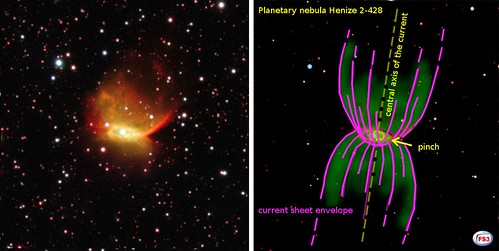Not only that astrogurus don't seem to understand this - usual phenomenon - they come up with even more phantastic, new explanations, every time they observe the same...
From SpaceCom: Doomed White Dwarf Stars to Spawn Supernova in Colossal Crash
This nebula is neither "oddly shaped" nor "asymetric". Problem although is that you have to comprehend the real physics behind planetary nebulas. We should recognize the usual pinching of the current, causing in its focus all kinds of electrodynamical effects, e.g. resonant or oscillating circuits:...The newly discovered pair of orbiting white dwarfs was first spotted by astronomers studying a planetary nebula called Henize 2-428, using ESO's Very Large Telescope.
The astronomers were initially studying Henize 2-428 because it is asymmetric, and scientists don't fully understand why some nebulae are oddly shaped...

The orbit of the alleged "two stars" is derived from the observation of the (regularly) flickering emissions and both the calculative deduction of their alleged masses - plus their ad hoc made up "separation"- derived again from the observation of the effect. Then you take whatever toy blocks you have at hands to "explain" the observation. In this case those toy blocks are "white dwarfs".
Case closed, astrophysics one step further away from reality again.
FS3




